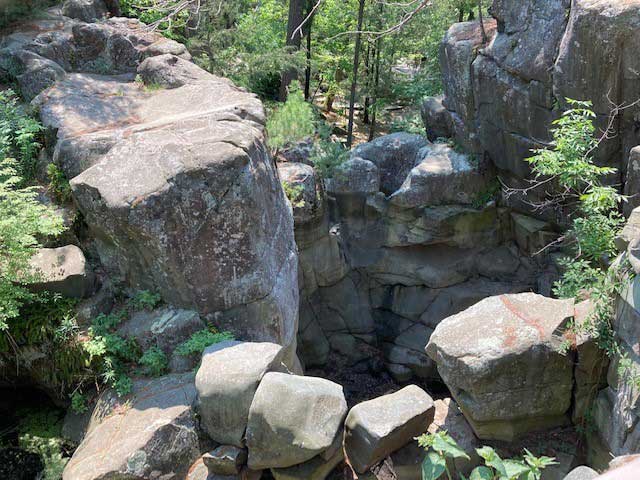Adventures at Interstate State Park
By Deborah Locke, DNR Information Officer
The thing about learning the past amid massive rock cliffs, green forest and a winding river is that it makes you feel miniscule. Maybe that’s a good thing. It’s like looking at an endless star-studded night sky. Sometimes our sweet, old earth puts us in our place while smiling back.
We were at Interstate State Park for the glacial pothole tour that began with a heap of large boulders that are over a 1 billion years old and located near the visitor center. Yup, a billion. Oh, how I wished that one big rock could talk and tell us what it knew.
Then again, knowledge accrued over a billion years takes more than an hour to reveal as we walked past rocks, cliffs and other remnants of Minnesota’s land formation. Jenni Webster, park naturalist, led a small group of the curious on a hot Sunday early in June.
You may presume that such an outing is best left to geologists or rock climbers scoping out the scenery, but the generalized interest in our small crew was pretty high. That’s because there’s something mysterious and cool about peering into a 60-foot deep near-perfect circle of basalt rock with its origin of erupting lava over a billion years ago, followed by glacial waters. The park’s 400 cylindrical holes were carved by swirling sand and water from a glacial river. The potholes and St. Croix River Valley formed a mere 10,000 years ago, making them newcomers to the landscape.
The above is a small sample of the information shared that hour as we walked to stunning views of a river winding through cliffs. On the Wisconsin side, rock climbers scaled steep walls. They provided a steady stream of conversation that easily carried over the St. Croix River to the Minnesota side.
That same river served as a logging industry freeway in the 1800s when thousands of white pine and other massive trees from virgin forests were felled and floated south to sawmills. The desire to preserve the area for future Minnesotans came to fruition in 1895 when Interstate State Park became the second state park in Minnesota.
Today more than 300,000 visitors flock to Interstate State Park each year to camp, hike, birdwatch, climb rocks, rent a canoe, and share a picnic lunch. On a warm Sunday, our tiny group followed the personable naturalists around and gained an understanding of the earth’s power in shaping its environment.
I often hear people heap praise on the beauty of U.S. Mountain ranges, deserts, forests, prairies, lakes, and canyons. However, you don’t need to load up a vehicle and drive a thousand miles to behold a majestic view and feel awe. Many of them are right here in Minnesota, where the earth once cracked, and lava poured and an Ice Age melted.
Interstate State Park is located at 307 Milltown Rd., Taylors Falls, MN 55084. For a schedule of naturalist programs at Minnesota state parks, go to mndnrgov/ptcalendar. Some programs require pre-registration; most are free of charge.
A park vehicle pass is required at Minnesota State Parks. The daily pass is $7 and may be purchased online at mndnr.gov/parkpermit, or at the park office. The annual pass is $35 and gives unlimited access to all state parks. Always check the park website for visitor alerts before you leave home.
Images courtesy Minnesota DNR Staff.

















